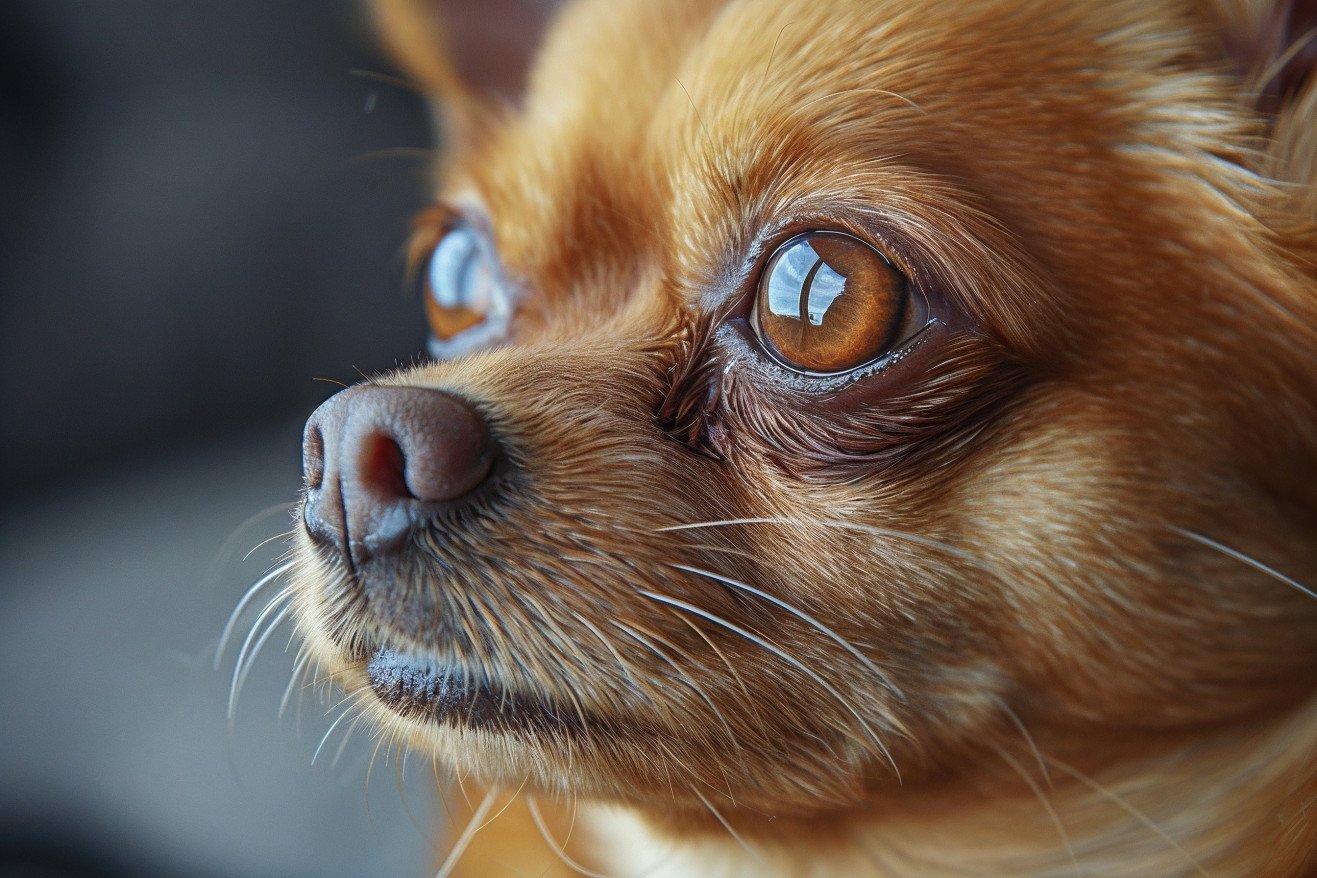Do Dog Whiskers Grow Back? The Science of Whisker Regrowth
15 February 2024 • Updated 14 February 2024

If you’ve ever asked yourself, “Do dog whiskers grow back?” you’re not alone. In fact, a dog’s whiskers will grow back after they’ve been cut or fallen out. Whiskers grow back naturally over the course of a few weeks to a few months. However, veterinarians recommend against cutting a dog’s whiskers because doing so can interfere with their ability to use them for important sensory purposes.
In this article, we’ll take a deep dive into veterinary research, scientific studies on hair and whisker regrowth, and research on the sensory systems of dogs. These sources have provided a comprehensive look at the importance of whiskers in dogs and the biological processes that occur when a dog loses and regrows its whiskers.
This information will not only answer your question but also give you a better understanding of your dog’s health and wellness.
Do dog whiskers grow back?
What Dog Whiskers Are Used For
Dog whiskers, or vibrissae, are long, stiff hairs that are rooted more deeply in the skin than regular fur. This means they are more sensitive to touch and other stimuli.
As The Honest Kitchen explains, dog whiskers are connected to a rich supply of nerves and blood vessels, which makes them highly responsive to the environment. They are a dog’s tactile sensory system, helping them with everything from getting around to social interactions.
When a dog’s whiskers come into contact with an object or changes in the air, the nerves at the base of the whiskers send important information about the dog’s surroundings to the brain.
FOTP notes that about 40% of the sensory cortex in a dog’s brain is devoted to processing information from the whiskers. Like the way humans use their fingers to feel objects, dog whiskers help dogs determine the location and feel of objects around them.
This is especially important in low-light situations and helps dogs avoid obstacles and other hazards. If a dog loses their whiskers or if their whiskers are damaged, they may lose this important connection to their environment, which can be very disorienting.
Business Insider adds that dogs also use their whiskers to communicate with other dogs. For example, a dog may move its whiskers in a certain way to show that it’s feeling aggressive or curious. This means that the health and well-being of a dog’s whiskers are important for their overall quality of life. Whiskers help dogs understand and interact with the world around them.
The Whisker Regrowth Process in Dogs
Whiskers grow back in dogs naturally and gradually. Like the hair growth cycle in other mammals, the process of whisker regrowth is cyclical. While the dormant phase or telogen stage is initially inactive until the new whisker starts to form, the anagen phase is the active growth phase. The catagen phase is the brief transition phase before the whisker re-enters the telogen phase.
According to Pawsafe, the time it takes for a dog’s whiskers to grow back completely can take anywhere from a few weeks to several months, and it depends on factors like the dog’s age and health.
A study published in PMC found that growth factors like FGFs can induce an earlier anagen phase in mice, which are similar to dogs in terms of hair and whisker growth, which could lead to potential treatments to help dogs grow their whiskers back.
One of the most common misconceptions about whiskers is that they are the same as regular hair. While both are made of keratin, whiskers are thicker, have a better blood supply, and are more deeply rooted. This is important to know because it impacts how we should care for and maintain a dog’s whiskers to make sure they are comfortable and able to interact with their surroundings.
Things That Affect Whisker Growth
Just like with humans, a healthy diet and lifestyle are important for a dog’s overall health, and this is no different when it comes to the regrowth of whiskers. A diet that is full of nutrients and includes the vitamins and minerals that a dog needs can help with the regrowth of whiskers.
A study in the journal PMC found that dermal papilla cells in the hair follicles, which are important for hair and whisker growth, need to have the right nutrients and a nontoxic environment in order to thrive.
There are also environmental factors, such as temperature and living conditions, that can affect how quickly and how well a dog’s whiskers grow back. A study in the journal BMC Genomics found that the hair cycle in animals like yaks is affected by the seasons, and this may be the same for dogs and their whiskers.
In addition, the way that a dog is groomed can also affect the growth of their whiskers. While there may be times when a dog’s whiskers need to be trimmed for medical reasons, if a dog’s whiskers are trimmed regularly, it can affect the dog’s ability to use their whiskers to sense their environment.
Dog owners should be careful and thoughtful about how they groom their dogs and avoid any unnecessary grooming that could affect the health of their dog’s whiskers.
In order to make sure that a dog’s whiskers grow back, it’s important to make sure that they are eating a healthy diet, that they are living in the right environment, and that they are being groomed in a way that is healthy for their whiskers. All of these things can help ensure that the natural process of regrowth is happening and that a dog’s important sensory tools are healthy.
How Whisker Loss Impacts Canine Behavior and Neurology
Whisker loss or damage can have a big impact on a dog’s behavior. Whiskers aren’t just there for show; they are sensory hairs that help dogs better understand their environment.
One study published in PMC shows that sensory deprivation, including whisker removal, has a significant impact on behavior and increases exploratory activity in whisker-dependent tasks. This means that dogs with compromised whiskers may engage in more investigative behavior, which could make them more vulnerable in their environment.
There is also a concern for neurological impacts. One study on mouse central trigeminal pathways, which was published in PubMed, found that whisker lesions can change the sensory map in the brain, which could have a similar impact on a dog’s neurological function when its whiskers are damaged.
These changes in the brain’s wiring show the adaptive importance of whisker regrowth, which ensures that dogs can still maintain their spatial awareness and sensitivity to touch.
Whiskers do grow back, which means that dogs can regain these important sensory functions. The resilience and regrowth potential of whiskers is an evolutionary adaptation that ensures that dogs can still effectively navigate and interact with their environment even after experiencing a loss or damage.
What This Tells Us About the Amazing Resilience of Dog Whiskers
So, the story of whisker regrowth in dogs is a confirmation of nature’s resilience. These important sensory organs, which are critical to a dog’s ability to interact with the world around them, are built to recover from loss and damage.
As we’ve learned, whiskers are so much more than just hairs; they are sensory organs that are important for a dog’s sense of navigation, communication, and more, and they are deeply integrated into a dog’s biology and behavior.
The fact that the process of whisker regrowth is cyclical and can be influenced by things like diet and the environment also shows us how important it is to be mindful of how we care for our dogs’ whiskers. Dog owners need to make sure that they don’t interfere with the integrity of these important sensory organs so that they can continue to help their dogs navigate the world and live their best lives.
As we’ve learned, whiskers are a great example of how dogs’ bodies can adapt to changes in order to continue to fulfill their important roles. They are also a great example of the fine line that exists between a dog’s biology and the world around them. The resilience of whiskers, while small, is an important part of ensuring that our dogs can continue to be aware, connected, and safe in their environments.


